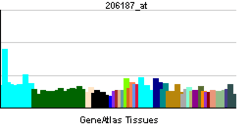Prostacyclin receptor
| View/Edit Human | View/Edit Mouse |
Prostacyclin receptor is a receptor for prostacyclin (a prostaglandin that is also called prostaglandin I2, PGI2). Its HGNC name is prostaglandin I2 (prostacyclin) receptor (IP) (symbol PTGIR; older synonymous symbol IP).
It is a member of the G protein–coupled receptor family. Prostacyclin, the major product of cyclooxygenase in macrovascular endothelium, elicits a potent vasodilation and inhibition of platelet aggregation through binding to this receptor.[4]
Transduction
When binding a prostacyclin-molecule, the receptor changes conformation and activates Gs, with its activation of cAMP and increase in protein kinase A (PKA) activity.
In vasodilation
In vasodilation, the PKA activity causes phosphorylation of MLCK, decreasing its activity, resulting in dephosphorylation of MLC of myosin. The smooth muscle relaxation leads to vasodilation.[5]
Gene
The receptor is encoded by the human gene PTGIR.[4]
See also
References
- ↑ "Drugs that physically interact with Prostacyclin receptor view/edit references on wikidata".
- ↑ "Human PubMed Reference:".
- ↑ "Mouse PubMed Reference:".
- 1 2 "Entrez Gene: PTGIR prostaglandin I2 (prostacyclin) receptor (IP)".
- ↑ Walter F. Boron (2005). Medical Physiology: A Cellular And Molecular Approaoch. Elsevier/Saunders. ISBN 1-4160-2328-3. Page 479
External links
- "Prostanoid Receptors: IP1". IUPHAR Database of Receptors and Ion Channels. International Union of Basic and Clinical Pharmacology.
Further reading
- Coleman RA, Smith WL, Narumiya S (1994). "International Union of Pharmacology classification of prostanoid receptors: properties, distribution, and structure of the receptors and their subtypes". Pharmacol. Rev. 46 (2): 205–29. PMID 7938166.
- Rauvala H, Peng HB (1997). "HB-GAM (heparin-binding growth-associated molecule) and heparin-type glycans in the development and plasticity of neuron-target contacts". Prog. Neurobiol. 52 (2): 127–44. doi:10.1016/S0301-0082(97)00007-5. PMID 9185236.
- Smyth EM, FitzGerald GA (2003). "Human prostacyclin receptor". Vitam. Horm. Vitamins & Hormones. 65: 149–65. doi:10.1016/S0083-6729(02)65063-0. ISBN 978-0-12-709865-4. PMID 12481546.
- Boie Y, Rushmore TH, Darmon-Goodwin A, et al. (1994). "Cloning and expression of a cDNA for the human prostanoid IP receptor". J. Biol. Chem. 269 (16): 12173–8. PMID 7512962.
- Katsuyama M, Sugimoto Y, Namba T, et al. (1994). "Cloning and expression of a cDNA for the human prostacyclin receptor". FEBS Lett. 344 (1): 74–8. doi:10.1016/0014-5793(94)00355-6. PMID 7514139.
- Ogawa Y, Tanaka I, Inoue M, et al. (1995). "Structural organization and chromosomal assignment of the human prostacyclin receptor gene". Genomics. 27 (1): 142–8. doi:10.1006/geno.1995.1016. PMID 7665161.
- Duncan AM, Anderson LL, Funk CD, et al. (1995). "Chromosomal localization of the human prostanoid receptor gene family". Genomics. 25 (3): 740–2. doi:10.1016/0888-7543(95)80022-E. PMID 7759114.
- Nakagawa O, Tanaka I, Usui T, et al. (1994). "Molecular cloning of human prostacyclin receptor cDNA and its gene expression in the cardiovascular system". Circulation. 90 (4): 1643–7. doi:10.1161/01.cir.90.4.1643. PMID 7923647.
- Bonaldo MF, Lennon G, Soares MB (1997). "Normalization and subtraction: two approaches to facilitate gene discovery". Genome Res. 6 (9): 791–806. doi:10.1101/gr.6.9.791. PMID 8889548.
- Sasaki Y, Takahashi T, Tanaka I, et al. (1997). "Expression of prostacyclin receptor in human megakaryocytes". Blood. 90 (3): 1039–46. PMID 9242534.
- Fisch A, Tobusch K, Veit K, et al. (1997). "Prostacyclin receptor desensitization is a reversible phenomenon in human platelets". Circulation. 96 (3): 756–60. doi:10.1161/01.cir.96.3.756. PMID 9264479.
- Smyth EM, Li WH, FitzGerald GA (1998). "Phosphorylation of the prostacyclin receptor during homologous desensitization. A critical role for protein kinase c". J. Biol. Chem. 273 (36): 23258–66. doi:10.1074/jbc.273.36.23258. PMID 9722557.
- Kömhoff M, Lesener B, Nakao K, et al. (1999). "Localization of the prostacyclin receptor in human kidney". Kidney Int. 54 (6): 1899–908. doi:10.1046/j.1523-1755.1998.00213.x. PMID 9853255.
- Hayes JS, Lawler OA, Walsh MT, Kinsella BT (1999). "The prostacyclin receptor is isoprenylated. Isoprenylation is required for efficient receptor-effector coupling". J. Biol. Chem. 274 (34): 23707–18. doi:10.1074/jbc.274.34.23707. PMID 10446129.
- Smyth EM, Austin SC, Reilly MP, FitzGerald GA (2000). "Internalization and sequestration of the human prostacyclin receptor". J. Biol. Chem. 275 (41): 32037–45. doi:10.1074/jbc.M003873200. PMID 10889200.
- Lawler OA, Miggin SM, Kinsella BT (2001). "Protein kinase A-mediated phosphorylation of serine 357 of the mouse prostacyclin receptor regulates its coupling to G(s)-, to G(i)-, and to G(q)-coupled effector signaling". J. Biol. Chem. 276 (36): 33596–607. doi:10.1074/jbc.M104434200. PMID 11443126.
- Zhang Z, Austin SC, Smyth EM (2001). "Glycosylation of the human prostacyclin receptor: role in ligand binding and signal transduction". Mol. Pharmacol. 60 (3): 480–7. PMID 11502878.
- Fortier I, Patry C, Lora M, et al. (2001). "Immunohistochemical localization of the prostacyclin receptor (IP) human bone". Prostaglandins Leukot. Essent. Fatty Acids. 65 (2): 79–83. doi:10.1054/plef.2001.0292. PMID 11545623.
This article incorporates text from the United States National Library of Medicine, which is in the public domain.
